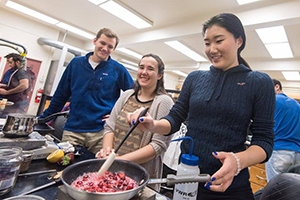Science
Chopped: A Chemistry Lab Cooking Challenge

Students cooking for the Chemistry of Food competition.
For a few days at the end of this semester, the halls of Beeghly filled with the smells of chocolate, simmering butter and sugar, cranberry-apple pie, and potato latkes.
It was all part of AU’s very own version of Chopped, the Food Network’s cooking show that challenges chefs to turn baskets of mystery ingredients into three-course meals.
At AU, the competition took place at the end of the semester in the Chemistry of Food class taught by chemistry professor Matt Hartings and professorial lecturer Sarongel Rodriguez. “Our students have been studying the science behind individual foods and techniques all year,” said Hartings. “This competition was a chance for them to put all of their training and preparation together into a single event. In educational terms, this was like a cumulative exam…only more fun.”
The Competition
At the beginning of the Chopped competitions, each pair of lab partners received a bag of five mystery ingredients, plus access to additional pantry items. In one hour, they had to prepare an appetizer or brunch dish that would be judged on creativity, appearance, and aroma.
“A successful dish will incorporate all of these ingredients in a creative and compelling manner,” said Hartings. “Chefs of a successful dish will also be able to put their chemistry knowledge to use in bringing together disparate ingredients into a cohesive plate.”
The students went to work, chopping, slicing, baking, frying, and sautéing their ingredients, using basic cooking utensils and Bunsen burners. “It’s a fun way to learn chemistry, and it actually applies to real life,” said Joanne Frangias (BS finance ’17). Her lab partner, Brook Friday (BA theatre ’17) added, “Now I can understand the processes of cooking and the chemistry behind them. It’s really useful because cooking is something you’ll do for the rest of your life.”
The Science Behind the Food
The students, who are all non-science majors, trained for the Chopped competition since their first week in lab, said Hartings. Each lecture and lab focused on scientific principles involved in cooking, including structure and function, acid/base chemistry, and reaction energetics. In the lab, students performed experiments on different types of food: they learned how to make yogurt from milk, why gluten holds breads and pastas together, and how to reduce the starch in potatoes to make crispy French fries.
Hartings credits professorial lecturers Rodriguez and Jane Ferguson for putting the Chopped competitions together. “We love this concept because it requires students to draw from all of their instruction in a single demonstration,” he said. “We also love this competition because our students are really able to show off their creativity. Many often see science as a dry subject. We contend that the opposite is true. Good science demands creativity! And our students, through this competition, prove that.”
Who Got Chopped
Inside the lab, students ran back and forth, putting the finishing touches on their projects before the clock ran out. Each team presented their dish and explained the science behind the food and their cooking techniques.
At the end, only one team survived the chopping block. But the teams produced a wide variety of creative dishes including chocolate-covered strawberries, a cranberry-potato pudding pie, and a chocolate-cranberry poutine with candied cranberries.
“Success in this event was easy to see. And we observed it any time a student’s idea didn’t work,” said Hartings. “When this happened, the students rethought what they were doing, modified their prep, and fixed their recipes. From a chemist’s perspective, they were applying the scientific method exactly as we hoped they would.”
Hartings hopes that the lessons learned in The Chemistry of Food will make a lasting impression. “Even if none of these students go into scientific professions when they graduate, they are all scientists while cooking in a kitchen. And we expect them to use the scientific mindset that they develop here after they graduate and leave American University.”

